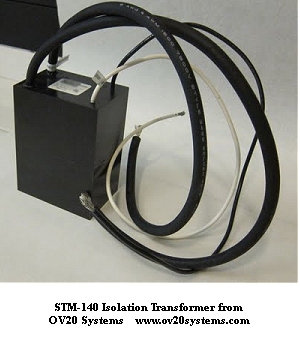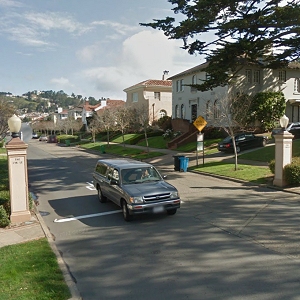|
Series Circuits
In their day, series circuits were the most efficient means of lighting in terms of lumens produced per watt. However the voltage across a typical series 6.6 amp 4000 lumen incandescent lamp was under 35 volts. These lamps, as well as the entire circuit, required a constant current in order to operate properly. Such a circuit would not be conducive to present day high efficiency lighting. So the issue at hand involves getting reliable 110 volt output from a 2+kv 6.6 amp series circuit.
As far back as the 1890s manufacturers produced isolation transformers for series circuits that could power subordinate multiple circuits of "line voltage" lamps, generally from 110 to 240 volts. That technology certainly worked, although it was not highly efficient and some transformers were found to produce radio frequency interference (RFI,) particularly when lamps failed and there was no load on the transformers.
 A modern version of the isolation transformer exists that is more efficient and does not produce RFI issues. An isolation transformer mounted in the base compartment of a luminaire (or pole mounted, where necessary) can reliably deliver 120 volts from a 6.6 amp constant current series circuit.
A modern version of the isolation transformer exists that is more efficient and does not produce RFI issues. An isolation transformer mounted in the base compartment of a luminaire (or pole mounted, where necessary) can reliably deliver 120 volts from a 6.6 amp constant current series circuit.
The STM-140 series isolation transformers made by
OV20 Systems operate on 6.6 amp series circuits. Regardless of voltage supplied by the constant current regulator, they deliver clean 120 or 240 volt power through secondary windings, sufficient for powering LED luminaires or any of a number of retrofits for classic luminaires.
Any isolation transformer selected should be designed to withstand both an open circuit and a short circuit on its secondary windings - just in case old wiring does short circuit or someone removes a "Jones" socket from its receptacle while the circuit is energized.
"Stab-in" and head mounted autotransformers.
Sequoia Lighting Corporation manufactures a whole line of "in head" autotransformers and kits, including "stab-in" retrofits that fit into Jones sockets. These kits directly supply HPS, CMH and similar improved efficiency lamps from existing series incandescent or mercury vapor circuits. For historic districts and other locations where aesthetic concerns apply, CMH retrofits can provide "incandescent-like" illumination on these old series circuits at a fraction of the cost of incandescent lighting.
An illustration of some of these kits appears below.

Sequoia also makes complete replacement luminaires designed to be served by traditional series circuits. A more complete copy of Sequoia's cut sheets can be found
here. (Large file, may take time to download.)
With 120 or 240 volts provided at the luminaire, or direct conversion for lower cost light sources without involving costly circuit replacement, the range of upgrade options expands exponentially.
Retrofit or Replace the Luminaire?
With the relatively low cost ability to provide 120 or 240 volts or direct supply to lower energy lamps from a series circuit, the next logical decision point involves whether to retrofit a luminaire, replace the luminaire head or replace the entire post and luminaire assembly.
There are a number of high efficiency luminaires that can be mounted on existing bracket arms and column posts that will preserve an historic look. Given that catalogs abound with such options, this section will focus on making existing luminaires more efficient rather than discuss replacements.
With NEMA style luminaires or post top luminaires having standard socket mounting hardware, a ceramic metal-halide (CMH) retrofit package or "stab-in" kit could be a relatively inexpensive and reliable option to replace a series incandescent lamp. Care should be taken to use a CMH replacement that is similar in light output as "trespassing" light can become an issue with higher intensity light sources. CMH produces a "natural" light that is generally not offensive and provides a high degree of color rendering. (A number of manufacturers such as Sequoia Lighting and Ray-Lite can also provide more modern globes for decorative post-top lamps that help reduce trespassing light.)
 Where changing out series socket hardware is problematic, the series lamp can be adapted to accept an HPS, CMA, CFL or LED replacement. When providing 110 volt service to series luminaires that have removable Jones sockets, it is important to replace the film cutout disk in the socket bayonet with appropriate insulating material, or if powered by an isolation transformer, use a "red dot" cutout that has a 250 volt breakover voltage. Failure to properly insulate the bayonet contacts from each other will create a direct short circuit and the lamp won't light.
Where changing out series socket hardware is problematic, the series lamp can be adapted to accept an HPS, CMA, CFL or LED replacement. When providing 110 volt service to series luminaires that have removable Jones sockets, it is important to replace the film cutout disk in the socket bayonet with appropriate insulating material, or if powered by an isolation transformer, use a "red dot" cutout that has a 250 volt breakover voltage. Failure to properly insulate the bayonet contacts from each other will create a direct short circuit and the lamp won't light.
If you can reliably deliver 120 volts to the lamp socket, whether through use of an autotransformer or in a luminaire now served bya 120 volt circuit, high output CFL or LED screw-in lamps can be very cost-effective lighting options in addition to the CMH kits.
| 
